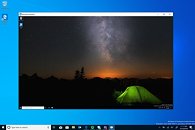Wednesday, December 19th 2018

Microsoft Windows Sandbox Securely Runs Suspicious Apps in Isolation
In an always-online world having the ability to test unknown programs or .exe files on PC has required the use of extra software which has always come with issues of its own or the more in-depth use of a virtual machine. In order to eliminate the fear of running unknown programs along with the desire to make testing them easier, Microsoft has announced the development of their Windows Sandbox. This new feature will be coming to Windows 10 Pro and Enterprise next year and as you may have guessed it allows for the creation of a temporary desktop environment. This work environment is made to be secure and disposable meaning you can run an app in the sandbox check for compatibility, possible issues, malware, etc and once done just delete the entire sandbox. Thus keeping your real operating system free and clear of any potentially hidden nasty surprises.
The entire system works by using Microsoft's Hypervisor to create an entirely separate kernel isolated from the host PC. Each time its run it creates a pristine installation of Windows as nothing persists between uses. More importantly, the prerequisites for its use are quite low, with systems currently at the minimum needing Windows 10 Pro or Enterprise Insider build 18305 or later, virtualization capabilities enabled in the BIOS, 4 GB of memory, 1 GB free disk space and 2 CPU cores. Recommended specifications include a CPU with four threads, 8 GB memory, and an SSD, which in this day and age is quite minimal all things considered. While this feature is not likely to be a game changer for the average consumer it should make the lives of IT personnel a bit easier.
Source:
Microsoft Blog
The entire system works by using Microsoft's Hypervisor to create an entirely separate kernel isolated from the host PC. Each time its run it creates a pristine installation of Windows as nothing persists between uses. More importantly, the prerequisites for its use are quite low, with systems currently at the minimum needing Windows 10 Pro or Enterprise Insider build 18305 or later, virtualization capabilities enabled in the BIOS, 4 GB of memory, 1 GB free disk space and 2 CPU cores. Recommended specifications include a CPU with four threads, 8 GB memory, and an SSD, which in this day and age is quite minimal all things considered. While this feature is not likely to be a game changer for the average consumer it should make the lives of IT personnel a bit easier.

16 Comments on Microsoft Windows Sandbox Securely Runs Suspicious Apps in Isolation
And no, I know about other third-party programs that do this, but I wanted something built-in.
Windows 7 Pro came with a copy of Windows XP Pro x64 for use in a VM. You had to download the package though. Didn't come on the DVD.
What they do now is an equivalent of Docker containers.
Still decades behind, dumb dumbs. Maybe next century you can have a grown up OS.
There is a big difference between "restricted access" and "running inside a container". Containers only gained traction a few years ago. Docker (the most popular multiplatform containerization software), got to its first public release only in 2013, and it's a thrid-party software. So, I'm not sure where this "since their inception" comes from.
skype in a sandbox
office in a sandbox
autoupdating W10 in a non-updating W10 sandbox
;)
Takes a sandbox to achieve security from any rando malware...laughable.